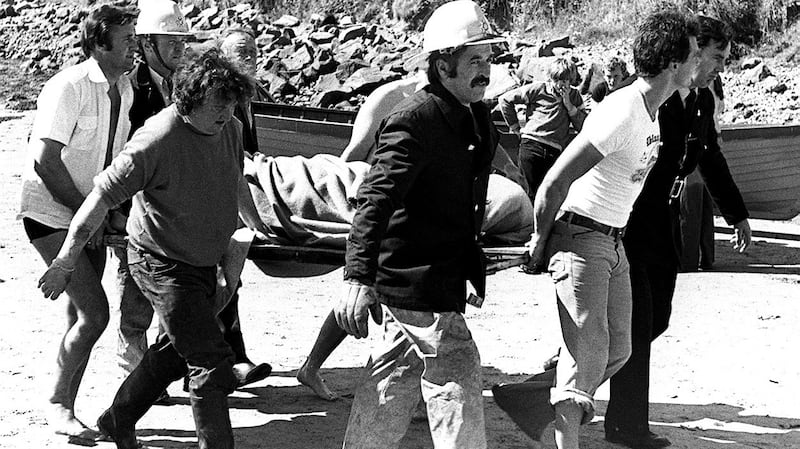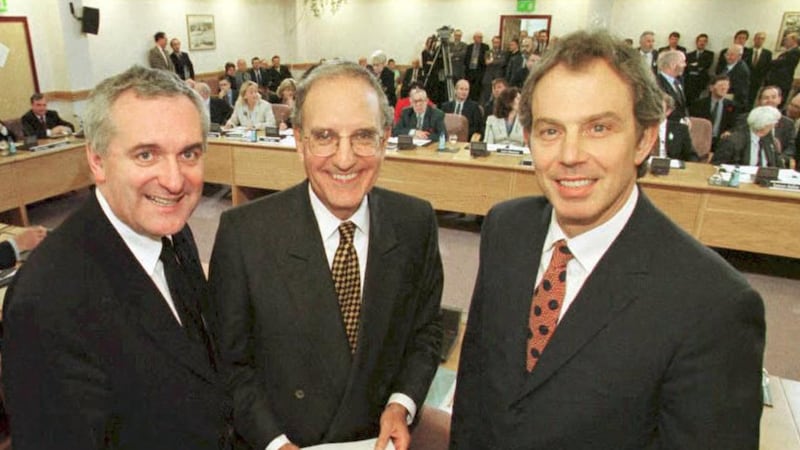Looking back over 25 years the principal memory is the waiting, the endless waiting in the car park of Castle Buildings, the ugliest building in the Stormont estate, if not one of the ugliest buildings anywhere in Northern Ireland.
Inside, over years, representatives from British and Irish governments, the major and minor political parties struggled to reach a deal that would, that could offer new beginnings under the direction of the sainted George Mitchell.
Over that period the notion of waiting seemed so appropriate because Ireland, indeed these islands, in a sense, had been waiting a few centuries for this moment. Borrowing from Samuel Beckett’s Waiting for Godot analogy, but this time Godot finally turned up.
From early April 1998 and long before, we knew a deal was possible, that there could be light at the end of the tunnel. But we also knew the working journalistic maxim that influenced so much of these events – and still does – that if Northern Ireland politicians “saw light at the end of the tunnel they’d buy more tunnel”.
READ MORE
Another maxim of The Irish Times office in Belfast – passed on from one Northern Editor to the next – was, whenever appraising or analysing significant moments, or what seemed real opportunities, to be pessimistic. Be pessimistic and you would never go wrong. But could this moment upend these certainties?
We waited in increasing numbers as the international media turned up, the world like the rest of us figuring this was a chance, that there was the real prospect of bringing finality – or close to finality – to three decades of violence and death.
And while the IRA and the main loyalist paramilitaries were on ceasefire, others were not. The previous month, in early March, loyalist Volunteer Force gunmen walked into a pub in Poyntzpass and shot several people, two of them fatally. Philip Allen, a Protestant, and Damien Trainor, a Catholic, were killed, they were two best friends who easily crossed the sectarian line, two people emblematic of what a new Northern Ireland could be.
There is a generation and more, understandably, who have no notion of what this place was like. There are others who would prefer to put it all behind them, but we shouldn’t forget. There are so many cities, towns and locations that you associate, not with places happily visited or passed through, but with slaughter: Derry, Kingsmill, Ballykelly, Dublin and Monaghan, Narrow Water, Mullaghmore, Enniskillen, Loughgall, Teebane, Shankill, Greysteel ... and on and on.
Mostly for journalists the job was appallingly, corrosively simple: it was the next killing, the next bombing, the next funeral
These made world headlines but other attacks live in the memory too. I remember the UDA shooting inside Sean Graham’s bookies on the Ormeau Road in Belfast in 1992. Five people picking out their horses were killed, the youngest was 15-year-old James Kennedy. His last words were: “Tell Mummy that I love her.”
I interviewed his father, Jack, two years later. By then he had lost not just his son but his wife Kathleen who, he said, “died of a broken heart”. There were many such instances. “The bullets that killed James did not just travel in distance,” he told me. “They travelled in time. Some of those bullets never stopped travelling.”
I remember covering the funeral of a police officer murdered by the IRA. At the funeral the young widow carried her son into the church. He was no more than two or three. He saw the bank of photographers and camera crews and cheerfully started pretending he was shooting at them, a big, happy smile on his innocent face.
At the end of the service he was still in his mother’s arms when they came out of the church, but this time there was no laughter for the cameras: he was in tears and pressed firmly into her shoulder, too young to fully understand but somehow conscious of a terrible act inflicted on him and his family.
A twisted normality
Over close to 30 years there was so much death and injury and so much trauma and physical and mental suffering that scars tens of thousands of people to this day. One wonders, too, about the perpetrators, the stories of depression, alcoholism and drug addiction among quite a number of former protagonists indicating how conscience is difficult to evade, although some seem to have managed.
That was regular life in Northern Ireland during the Troubles. After the failed Sunningdale Agreement and Executive respectively of 1973 and 1974 there was precious little meaningful politics. Mostly for journalists the job was appallingly, corrosively simple: it was the next killing, the next bombing, the next funeral.
For everyone it was an abnormal life but it had gone on for so long that it had established a twisted normality. People adapted through a fatalistic enduring, an almost acceptance of the violence, of the RUC Land Rovers and British army armoured personnel carriers patrolling the streets, the helicopters overhead, the seemingly endless bomb scares and holdups, being able to distinguish between the sound of a bomb and a thunderclap or firecracker, the searches when shopping in town, the anxiety when driving at night along narrow country roads.

Most wars end after a short number of years but this conflict, whatever it should be called, seemed destined to run on. It affected almost every facet of life. In our little office in Belfast there were six of us, three reporters, an office manager, a man who managed an ancillary Irish Times company and a part-time secretary. The fathers of the latter two, the least bitter of people – one of the dads a greengrocer, the other a businessman – respectively were murdered by the UVF and the INLA. There were many such stories in many offices across Northern Ireland.
You try not to repeat too often what was written before but in this moment of reflection it is difficult not to till some old ground. For me one of the great questions posed during the Troubles was in August 1979 when an IRA bomb claimed the lives of Lord Mountbatten, Lady Doreen Brabourne and two teenagers, 14-year-old Nicholas Knatchbull, Mountbatten’s grandson, and 15-year-old Paul Maxwell from Enniskillen. They were all in Mountbatten’s Shadow V boat just off Mullaghmore in Co Sligo when the blast ripped the little craft apart.
I will never forget Paul Maxwell’s father, John, running along the pier in Mullaghmore and crying repeatedly as his son’s body was brought in a half-decker boat to the pier wall
I worked in the Donegal Democrat at the time, which was fairly close by in Ballyshannon, and we were the first reporters at the scene. I will never forget Paul Maxwell’s father, John, running along the pier in Mullaghmore and crying repeatedly as his son’s body was brought in a half-decker boat to the pier wall: “Look what you’ve done to him, look what you’ve done to him. I’m an Irishman, he’s an Irishman, is this the sort of Ireland you want?”
For the majority there was only one answer but others, the people with the balaclavas, the Kalashnikovs, the Semtex and the gelignite, had a different answer: they thought they could kill and bomb their way to a united Ireland or bomb and kill their way to preventing a united Ireland. And more than 25 years on from 1969 some were still at it while others, we feared, might revert to doing what they knew best if the politicians could not come to an agreement.
‘Hand of history’
Here we were at Castle Buildings, waiting to see if this was a pivotal moment in Irish history. Could we say goodbye to most of the badness? People knew in their gut what was at stake.
The foundations already had been laid. In the early part of the 1990s John Hume had had his talks with Gerry Adams that opened up the possibility of the IRA quitting the stage and the loyalists following suit. That led to the Downing Street Declaration created by Albert Reynolds and John Major. That in turn helped provide the basis for the IRA and loyalist ceasefires, and it was now down to Bertie Ahern and Tony Blair to get the disputing parties over the line. But there were no guarantees.
Tensions were electric particularly within the then major unionist party, the UUP, in the run-up to Good Friday, and especially for its leader David Trimble. But there were pressures on the other parties too. There was horse-trading, there was give and take on previously intractable issues such as a workable powersharing Stormont administration, on North-South bodies, on prisoner releases, on the RUC, on decommissioning – policing left to a commission to sort out and disarmament long-fingered for another day, although getting rid of the guns ran for another seven years before it was settled.

I remember standing in the hall of Hillsborough Castle when Tony Blair spoke about feeling the “hand of history” on his shoulder. We groaned as he tried and failed to make it sound like an impromptu remark when we suspected it was scripted by Alastair Campbell or someone else in his back room team.
Regardless, a cliche had been coined and, like most cliches, it carried a truth. The whole island also sensed that there could be a resolution to an age-old dispute. And remarkably – and even now what was achieved still feels remarkable just as it felt remarkable on that day – the compromises were made, the risks were taken, the deal was done.
At about 4.45pm David Trimble, who had to make the biggest call, told the talks chairman, the former US senator George Mitchell, that he and his party would sign up for the agreement. Mitchell, sensing he must move swiftly in case last-minute stage fright caused a collapse, called a plenary session of the talks’ participants for 15 minutes later where the parties formally endorsed the agreement, Gerry Adams offering the qualification “subject to consultation”.
We got the document. There were press conferences. Reporters rushed back to their offices or hotels to write their reports and analyses as did we to our office on Great Victoria Street five miles away in central Belfast. Jill Russell, who ran the office, had two bottles of champagne waiting to mark the day and the accomplishment. When that office expenses claim went to Dublin there were some raised eyebrows on the news desk and in the accounts department. But Good Friday 1998 was well worth two bottles of champagne.
When the stories were written and filed we managed to book a late table at a favourite nearby restaurant, La Belle Epoque, on the Dublin Road, now sadly gone – and we put that on expenses too. We ate, drank and chatted late into the night and into part of the following morning, exhausted, but on this Easter weekend thankful and conscious of a new beginning, a new hope.















